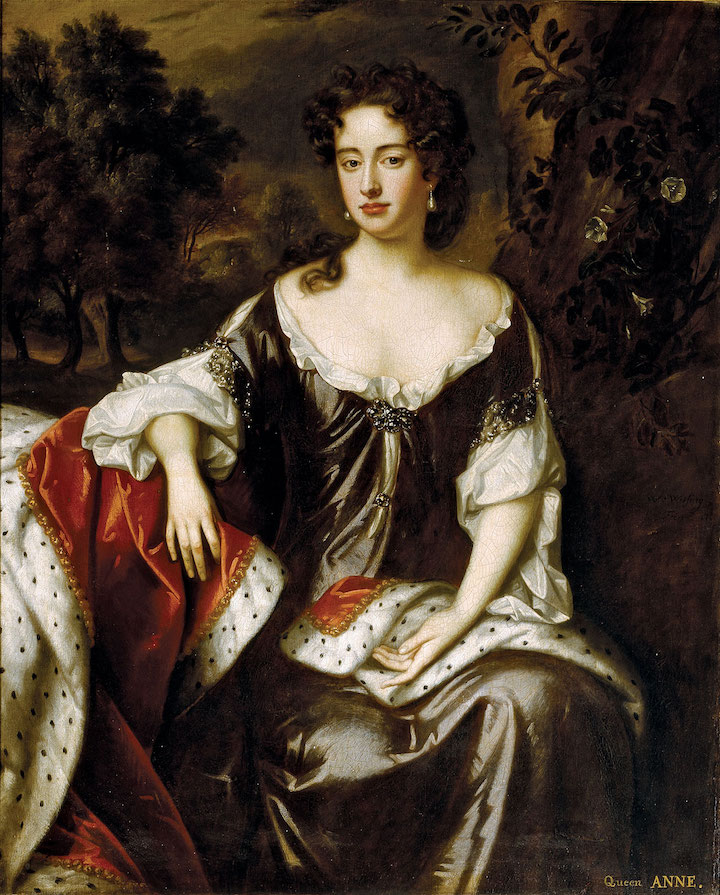
The Politics of Passion
She deposed her father, created a 2-party system, and single-handedly created Great Britain. Contributor MATTHEW FLACKS visits the Lady Anne Somerset in London to discuss Queen Anne: The Politics of Passion.

Highclere Castle
Political maneuvering, debt ceilings, wars raging abroad, lurid accusations and questions over national identity. Sound familiar? Who needs the fantastical Game of Thrones when you have the rich reign of an undervalued and belittled queen to reference? Award-winning British author and historian Lady Anne Somerset has written an illuminating book on one of the more unglamorous Kings and Queens of England, and realigns the chauvinistic misconception that Queen Anne was merely an obese, ill-educated and obsessive lesbian. Aptly titled ‘Passion and Politics,” Somerset’s unique aristocratic insight would’ve wiped the floor with any of the tedious Red top tabloids of the 18th century, yet sits comfortably in today’s national and cultural narrative of historical relevancy.
Family strife? Tick. Queen Anne was a protestant princess who conspired against her father and half-brother to ensure that their religious persuasions would not prevail, ultimately betraying them both for her own ideology. Political Reformation? Tick. She ruled over a transforming society in terms of its culture and its conscience; subduing conflict between the Whigs and Tories, creating a 2-party system in parliament, and uniting England and Scotland into a combined Great Britain. Economically crippling wars abroad? Tick. She oversaw wars that established, fortified and expanded her realm, quickly brought them to an end, and left the treasury significantly buttressed on her death. Personal tragedy? Tick. She had seventeen pregnancies, one surviving child that died at the age of eleven, and suffered from a crippling illness known as Gout: the disease of Kings. Finally, she was cast as an indecisive recluse, married to a dull, uninspiring prince and suspected of a lesbian affair with an ambitious lady-in-waiting. Who needs Downton Abbey when you can curl up with this?
I meet Lady Anne Somerset at her comparatively modest townhouse in the heart of London. A world away from Badminton House, the country manse of her youth, there are still declarations of her privilege; such as historical chattels on the walls, the airs and graces of landed gentry, and their signature touch of self deprecation. “Shabby Chic,” she says of the furnishings, “but maybe without the latter.” She is intelligent, engaging, and sticks to the brief. Well, sort of. Her father, the 11th Duke of Beaufort, is an English Peer whose dukedom coincidently dovetails with the reign of England’s James II in 1682. Her husband, however, the late Matthew Carr, was an Andy Warhol groupie that brought what the Daily Telegraph called a “ferocious concentration and psychological introspection to his classical drawings.” This modest and somewhat bohemian existence is where the couple studied society through their art, and, albeit in Kensington, intersects somewhere along that fantastical line where privilege and pragmatism began to blur onto the pages of “Queen Anne: The Politics of Passion.”
With access to previously unseen archives, Somerset began to document the personal relationships that may have shaped the Queen for a time of social transition and cultural transformation beginning with her father, James II. Anne’s decision to betray the King was “high-minded” and “not wholly attractive,” Somerset says, explaining that the Divine Right of Kings is both a political and religious distinction which asserts that the monarch is subject to no earthly authority. Nevertheless, Anne wanted the crown—and took it. The cut-and-thrust of 18th century politics wasn’t new. But neither was it ensconced with women. Anne had learned the art of the hostile takeover from her predecessors, and, as a pretender to the English throne, relished in and exercised her prerogative. Somerset continues. “And she didn’t waste time with the issue of feminism.” Monarchs are born to rule: a mantra Anne rejected when her father was on the throne, but one that served her well throughout her own reign.
A Glorious Revolution taught the young Princess how to collaborate
She ascended the throne in 1702 as the Queen of England. But after a mere 12 years wrought with consolidation, war, merger and acquisition, she laid-in-state at Westminster Abbey on August 24, 1714 as Queen of a political collateral now known as the Kingdom of Great Britain. How she accomplished this was due very simply to her resolve to be present. Indeed, she attended more cabinet meetings than any of her predecessors or successors combined. Today we call this Client Facing: where face-to-face communications expedites conflict resolution, human capital, and collaboration. Moreover, Anne was the last British sovereign to veto a bill in parliament when she refused to give “Royal Assent” to the Scottish Militia Bill. Passed by parliament in 1708, Anne withheld Royal Assent based upon observances that a conjoined Scottish military might be disloyal to the crown. With opinion running rampant in every direction, the importance of being actively present and discerning was and remains fundamental to the power of politics.
But it was the 2-party system for which Anne is best known. The “passion” in Somerset’s subtitle also refers to those aroused by party politics. The terms “Whig” and “Tory” were originally intended as insults. They were derived during the reign of Anne’s grandfather, Charles II, to denote the hostile factions who disagreed over whether James II’s Catholicism should exclude him from inheriting the throne. The labels stuck, as did the bitter divisions, while the Queen was successful in keeping her head above the political fray. The importance of questioning our leaders and creating a political dialogue came into play without constitutional crisis, and was the precursor to the banter we oft see on the House floors today.
The newly combined England and Scotland had created Europe’s largest free trade area, and best sellers like Daniel DeFoe’s Robinson Crusoe and Jonathan Swift’s Gulliver’s Travels were shaping a new, uniquely British national identity. The image of Britannia emerges on the half penny in the Queen’s likeness, whilst the very first bets are placed at Ascot. The personification of Britain’s power, wealth and personality had effectively entered an Age of Adventure. However, Anne’s Great Britain wouldn’t emerge as a Superpower for another 100 years until the advent of the Industrial Revolution. British discoveries like the steam engine were patented during her reign, and by the dawn of the 20th century marvels like the steamship, modern factory and railway had ushered one-fifth of the world’s population to the Empire. But for conciliators like Anne, however, who preferred to collaborate rather than conquer, today’s Commonwealth of Nations might be plagued by irascible politicians rather than consulted, warned, and encouraged by a Queen.
Her father ruled by Divine Will, whilst Anne was the first in a parade of savvy, constitutional monarchs to understand the importance and Will of the People. “I would not open windows into men’s souls,” her predecessor Elizabeth I famously said, when asked to force her catholic subjects to become protestant. Famously situated outside St. Paul’s Cathedral, Queen Anne, the iconic statue by Sir Francis Bird, seems to be enjoying her view.
Archives








